Abstract
Black hole shadow and gravitational lensing play important roles in testing gravitational theories in the strong field regime. As the first-order modifications from quantum gravity, the nonlocality can be manifested by black hole shadow and gravitational lensing. For example, the nonlocal parameter introduced by nonlocality will affect the shape and size of the black hole shadow, and also affect the deflection angle of light rays. In this paper, we mainly investigate the effects of the nonlocality on the black hole shadow and the gravitational lensing for two types of rotating black holes in nonlocal gravity. It is found that the size of the black hole shadow decreases with the nonlocal parameter since the nonlocality weakens the gravitational constant, and the shape of the shadow becomes more deformed with the increase in the nonlocal parameter. However, if the rotation parameter is small, the shape of the shadow is almost a circle even though the nonlocal parameter approaches its maximum. The energy emission rate in both models is also studied. The results show that there is a peak for each curve and the peak decreases and shifts to the low frequency with the increase in the nonlocal parameter. In addition, we also explore the shadow of both types of black holes surrounded by a nonmagnetized pressureless plasma which satisfies the separability condition. It is found that the plasma has a frequency-dependent dispersive effect on the size and shape of the black hole shadow. For the gravitational lensing, we find that the nonlocal parameter of model A makes a positive contribution to the deflection angle, which can be compared with the contribution of the rotation parameter, while the nonlocal parameter of model B makes a negative contribution which can be ignored. These results may be helpful for probing nonlocal gravity in future observations.
1. Introduction
As a prediction of Einstein’s general relativity (GR), black holes are invisible objects usually believed to be formed in the gravitational collapse of massive astronomical objects. It is well known that photons emitted from an illuminated source behind a black hole will form a two-dimensional dark zone in the observer’s sky, which is the so-called black hole shadow. As an imprint of the black hole, the black hole shadow provides us with valuable information about the black hole. For example, one can extract the spin and charge of the black hole [1,2,3,4,5,6] and constrain some new parameters introduced by modified gravities from the black hole shadow [7,8,9,10,11]. The shadow cast by a spherically symmetric black hole, which is a perfect circle, was first investigated by Synge [12] and then by Luminet [13]. They also introduced formulas to calculate the angular radius and size of the shadow, respectively. The shadow cast by a Kerr black hole was first studied by Bardeen [14]. The shape of the shadow is deformed due to the dragging effect. Since then, the black hole shadow has been extensively investigated in the literature. For instance, the black hole shadow and photon sphere in dynamically evolving spacetimes were investigated in ref. [15]. The effects of the cosmological constant on the black hole shadow were explored in refs. [16,17,18,19]. The shadow of a rotating regular black hole was explored in refs. [20,21]. In ref. [22], the authors calculated the shadow of a model-independent parameterized axisymmetric black hole. The relations between the radius of the black hole shadow and the quasinormal modes in the eikonal limit were found in refs. [23,24,25]. Many other representative investigations on the black hole shadow have been carried out in, e.g., refs. [26,27,28,29,30,31,32,33,34,35,36,37].
In addition to being captured, the escaped light rays will be bent by black holes, which is known as the gravitational lensing effect. As another powerful tool, the gravitational lensing also provides us abundant information about black holes, such as the position, mass, and angular momentum of black holes. Since the first detection of the deflection angle of light by the sun, the gravitational lensing has been extensively studied for black holes, wormholes, cosmic strings, and other objects by the geodesic method [38,39,40,41,42,43,44]. In ref. [45], Gibbons and Werner introduced an alternative method to calculate the weak deflection angle of light by a spherically symmetric black hole in the context of the optical geometry with the Gauss–Bonnet theorem. Then, Werner extended this method to the stationary black holes by using the Kerr–Randers optical geometry [46]. With the Gibbons and Werner’s methods, the weak deflection angle by different black holes in different gravitational theories was widely studied in refs. [47,48,49,50,51,52,53,54,55]. Furthermore, the Gauss–Bonnet theorem has also been used to investigate the weak deflection angle of massive particles [56,57], charged particles [58], and for the finite receiver and light source [59,60,61] in recent years.
In addition, for most astronomical situations, the influence of a plasma on light rays can be neglected but this is not true for the light rays in the radio frequency range. A well-known example is the effects of the solar corona, which is considered as a nonmagnetized pressureless plasma, on the time delay [62] and deflection angle when the light rays propagate near to the Sun [63]. Later on, Perlick performed a detailed investigation about the influence of a nonhomogeneous plasma on the light deflection in the Schwarzschild spacetime and in the equatorial plane of the Kerr spacetime [64]. The effects of plasma on light propagation have attracted more and more attention since then. For instance, the influences of plasma on gravitational lensing by black holes and compact objects were investigated in refs. [65,66,67,68,69,70]. The shadows of black holes and wormholes surrounded by plasma were investigated in refs. [71,72,73,74]. For a review, see ref. [75].
On the other hand, one of the most important motivations to study quantum gravity is the quest of ultraviolet complete gravitational theories, which may avoid spacetime singularity. Although we do not have a well-developed quantum gravity theory yet, there are many attempts, such as loop quantum gravity and string field theory. Almost all of these approaches include a common prediction that there should be an intrinsic extended structure in the spacetime [76], which is at the order of the Planck length. Such an extended structure indicates the nonlocality of the spacetime [77,78,79,80]. Thus, it is believed that the first-order modifications from quantum gravity would be the nonlocal correction of GR [81,82,83,84]. As one of the current candidate quantum gravitational theories, nonlocal gravity has been extensively studied in the literature. For instance, it was shown that nonlocal modifications offer a well-behaved ultraviolet complete quantum gravity which can be super-renormalizable [85,86,87,88]. The infrared nonlocal modifications of GR have been investigated in refs. [89,90,91,92], which can be used to explain the late-time cosmic acceleration. In refs. [93,94,95], the cosmological perturbation was analyzed and it was found that the IR nonlocally modified gravity not only performs well at the scale of the solar system as GR but can also provide a good fit to cosmic microwave background, baryon acoustic oscillation, and supernova data, as well as the CDM model.
As special astronomical objects, black holes play an important role in probing the strong gravity regime where the quantum effects may dominate. Thus, it is reasonable to study the black hole with quantum corrections. As the first-order corrections from quantum effects, it is interesting to consider the black hole in nonlocal gravity. The spherically symmetric static black hole in nonlocal gravity has been considered in refs. [82,96,97,98,99]. However, most astrophysical black holes are formed with rotation. Thus, it is worth investigating the spinning black hole in nonlocal gravity. Additionally, to obtain deep insight into the characteristics of the nonlocally modified black hole and investigate the effects of the nonlocal modifications on the black hole, it is necessary to study the shadow and weak deflection angle of the black hole in this gravitational theory. Furthermore, an astronomical object, including black holes, is usually surrounded by plasma. Thus, it is also necessary to investigate the effects of the plasma on the black hole shadow.
This paper is organized as follows. In Section 2, we give a brief review of the nonlocally modified gravitational theory and discuss two kinds of spherically symmetric black hole solutions. In Section 3, the rotating black hole solutions in the nonlocal gravity are presented and the null geodesics of the spacetime of these two types of rotating black holes are obtained. In Section 4, we investigate the effects of the nonlocality on the black hole shadow. In Section 5, the energy emission rates of both models are investigated. The effects of a nonmagnetized pressureless plasma on the black hole shadow are analyzed in Section 6. Section 8 gives the conclusion.
2. A Brief Review of the Nonlocal Gravity
In this section, we first give a brief review of the nonlocal gravity and then discuss two kinds of spherically symmetric black hole solutions. One can see ref. [96] for more details and discussions. We begin with the following action [82,85,96]:
where
where is an entire function of the dimensionless covariant d’Alembertian operator, i.e., with l as a fundamental length scale of the theory. is originated from an ultraviolet complete quantum gravity where the Newton’s constant is replaced by [82]. This theory not only is ultraviolet complete but also satisfies unitarity to all orders of perturbation theory. Furthermore, it should be stressed that here the d’Alembertian operator appears in the denominator, and thus the Lagrangian is actually not a total derivative. is the action for the matter field. Varying the action (1) with respect to the metric , one can obtain the following equations of motion [82,85,96]:
By shifting the operator to the right hand side, the above equations can be rewritten as [96]
where the effective energy momentum tensor is defined as , which is divergence free.
Assuming that the matter field is a pressureless static fluid at the origin, the component of its energy momentum tensor can be expressed as
where M is the mass of the source and is the usual delta function. Due to the spherically symmetric static fluid, the metric of the spacetime can be assumed as
where the metric components and are assumed to be identical for simplicity.
Inserting the metric (6) into Equation (4), the metric component can be solved as
where the effective Newton’s constant is defined by
which incorporates all the nonlocal effects and should reduce to Newton’s constant for . Before solving , one has to specify the form of . In this paper, we will take the following two models as examples.
2.1. Model A
We start with model A by assuming [96]
where l is the scale of the nonlocal parameter. In the free-falling Cartesian-like coordinates, the component of the effective energy momentum tensor can be conveniently calculated as
Then, the effective Newton’s constant can be expressed as
It is interesting to find that the solution of this model not only matches those derived in the context of asymptotically safe gravity [100] but also the noncommutative geometry inspired black holes except for l being replaced by [101].
For , can be expanded as
which indicates that the effective Newton’s constant reduces to Newton’s constant G at a large distance and the metric (6) tends to the Schwarzschild spacetime. On the other hand, one can expand for as
which indicates that this theory is asymptotically safe [102].
Figure 1 shows the shapes of for different l. It is obvious that the nonlocally modified gravitational theory reduces to GR in the infrared limit and is asymptotically safe in the ultraviolet limit.
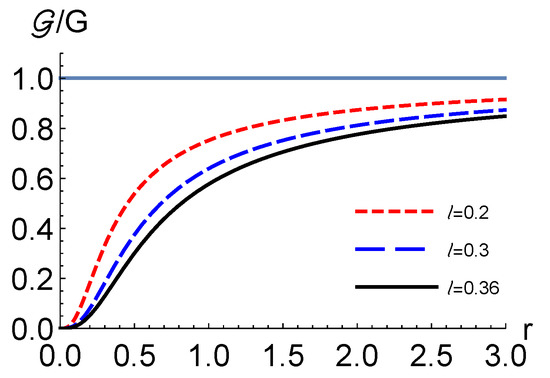
Figure 1.
Shapes of the function .
Let us then check the regularity of the spacetime of model A by calculating the following curvature invariants:
It is obvious that the scalars R and are finite everywhere but the regularity of is implicit. For , the Kretschmann scalar can be expanded as
which is regular as desired. Thus, one can conclude that the spacetime of model A is free of singularity. However, it should be pointed out that this model had been excluded based on the validity of the principle of least action at large distances [103].
2.2. Model B
As another example, inspired by the generalized uncertainty principle effects in the gravitational field [97], we consider the following function [96]:
where is the scale of the nonlocal parameter. Then, the effective energy momentum tensor can be calculated as
The effective Newton’s constant reads
where is the incomplete gamma function. Figure 2 shows that the effective Newton’s constant is zero at the origin and approaches Newton’s constant at a large distance, which indicates that model B is also asymptotically safe in the ultraviolet limit and reduces to Einstein’s general gravity in the infrared limit. However, the singularity at the origin is not removed, which can be seen from the short scale behavior of the Kretschmann scalar
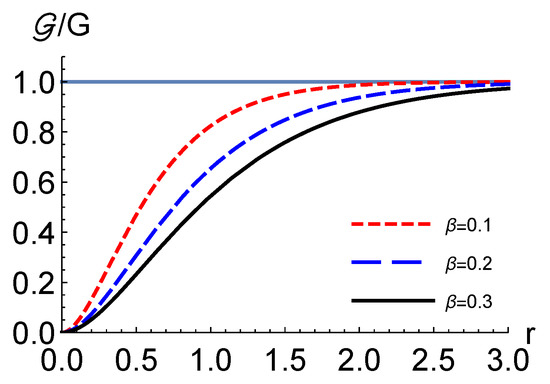
Figure 2.
Shapes of the function .
3. Spinning Nonlocal Black Hole and Circular Photon Orbits
The Newman–Janis algorithm (NJA) is a generating method for constructing rotating black hole solutions from static ones [104]. This method works well in producing Kerr black holes from Schwarzschild black holes [104] and Kerr–Newman black holes from Reissner–Nordström black holes in general relativity [105]. However, for other spherically symmetric black holes in modified gravitational theories, their rotating counterparts obtained by using the NJA will introduce additional sources [106,107,108,109]. We derive the rotating black hole solution in the nonlocal gravity by using the NJA without complexification [110], which has been successfully used to generate imperfect fluid stationary and rotating solutions from spherically symmetric ones. In this section, we first present the rotating counterpart of the spherically symmetric static solution in the nonlocal gravity and then investigate the photon orbits in this background. In the Boyer–Lindquist coordinates, the resulting rotating solution reads as
where
with a as the rotation parameter. Different from the case of a spherically symmetric static solution, the rotating solution (22) needs some fluid or other nonvacuum sources, which is a complex question worth studying in future work. Here, we will investigate the effects of the nonlocal parameter on the lensing of light in this geometry.
The event horizon of this rotating black hole is determined by
The feasible ranges of the rotation parameter a and the nonlocal parameters l and are determined by the existence condition of the horizons , where is given by the zeros of . In Figure 3, the parameter spaces and are shown as the light pink regions. In the following, we adimensionalize all quantities with the mass of the black hole and set Newton’s constant to one.
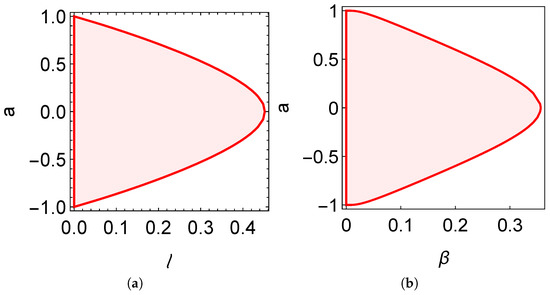
Figure 3.
The parameter spaces determined by the existence condition of black hole event horizon. Panels (a,b) show the cases of models A and B, respectively.
3.1. Equations of Null Geodesic Motion
The motion of a photon in the black hole spacetime can be described by the Lagrangian
where , is the photon’s 4-velocity, and is the affine parameter. Then, the energy and angular momentum are given by
Due yo the stationary and axisymmetric properties of the spacetime, both the energy and angular momentum are conserved.
The corresponding Hamilton–Jacobi equation is given by [111]
Considering the symmetry of the spacetime and the separability of the solution, the Jacobi action S for photons can be assumed as
where and are only functions of r and , respectively. Substituting Equation (29) into Equation (28), one can obtain [111,112,113,114]
where
and is the Carter constant [115]. These equations determine the null geodesics of the spacetime of the rotating nonlocally modified black hole. The plus and minus signs in the radial Equation (32) correspond to the outgoing and ingoing photons, respectively. The plus and minus signs in Equation (33) correspond to the photons moving to the north () and south () poles, respectively.
3.2. Unstable Circular Photon Orbits
The silhouette of the black hole is formed by the unstable circular photon orbits with constant r, which should satisfy
From the above two conditions, one can obtain [111,112,113]
where and are two constants, which are important for determining the contour of the black hole shadow. The prime denotes the derivative with respect to the radial coordinate r.
4. Shadow of Black Hole
In general, if there is a black hole between a light source and an observer, the photons with small orbital angular momentum emitted from the light source will be absorbed by the black hole and form a dark zone in the observer’s sky, which is known as the black hole shadow. To investigate the shadow viewed by a static observer located at infinite distance, we use the following basis vectors [111,112]:
with . The projected four-momentum of the photon with respect to the observer is given by
Then, the celestial coordinates on the plane of the observer’s sky can be calculated as [111,112,113,114]
where is the angle of inclination between the rotation axis of the black hole and the line of sight of the observer. We mainly focus on the influence of the nonlocal correction on the shadow. Thus, for simplicity, we assume that the observer is located at the equatorial plane of the black hole, i.e., . Then, the celestial coordinates reduce to
Figure 4 and Figure 5 present the shadows of the rotating black holes of model A and model B with different rotation parameters and nonlocal parameters, respectively. It is obvious that the silhouette is more deformed with the increase in the rotation parameter a for fixed nonlocal parameter l or while the size of it almost remains the same except shifting to the right; see Figure 4a and Figure 5a. Additionally, Figure 4b and Figure 5b show that the silhouette is also more deformed with the increase in l or for fixed a. However, the deformation is suppressed when the rotation parameter is small even if the nonlocal parameter approaches its maximum; see Figure 5b.
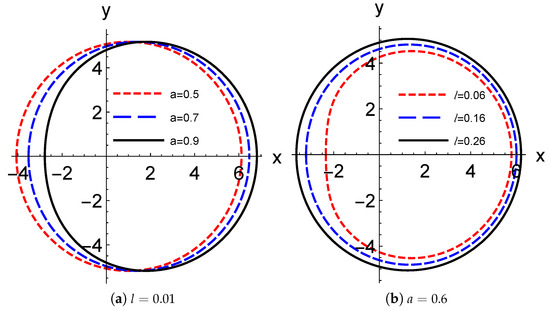
Figure 4.
The shadow cast by the rotating black hole in model A. Panels (a,b) show the effects of the rotation parameter a and the nonlocal parameter l on the black hole shadow, respectively. Here, the black hole is located at the origin of coordinates with the angle of inclination .
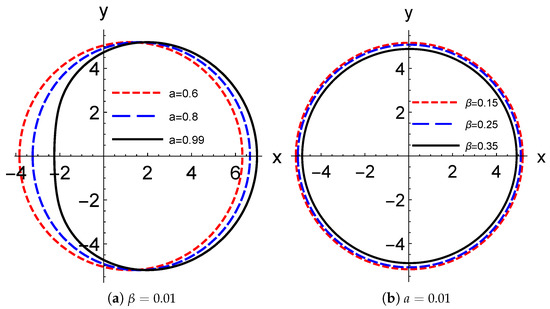
Figure 5.
The shadow cast by the rotating black hole in model B. Panels (a,b) show the effects of the rotation parameter a and the nonlocal parameter on the black hole shadow, respectively. Here, the black hole is located at the origin of coordinates with the angle of inclination .
In order to determine the important astronomical information of the black hole, it is necessary to construct some astronomical observables. Following Hioki and Maeda’s proposals [4], two observables are introduced to characterize the apparent shape of the shadow, i.e., the radius and the distortion parameter . The observable is the radius of a reference circle passing through three points: the top point (, ), the bottom one (, ), and the rightmost one (, 0) of the shadow. The distortion parameter measures the deformation of the shadow with respect to the reference circle and is defined as , where D is the difference between the leftmost points of the reference circle and of the shadow.
After a simple algebra calculation, these two observables can be expressed as [4,21,27]
where and are the points where the reference circle and the contour of the shadow intersect the horizontal axis at the opposite side of , respectively.
Figure 6 and Figure 7 show the observables and of the black hole shadow of model A and model B as a function of the nonlocal parameter l or for the different values of the rotation parameter a, respectively. It is obvious that the observable decreases with l or . The reason is that with the increasing l or , the effective gravitational constant will decrease (see Figure 1 and Figure 2), and hence the gravitational force acting on photons becomes weaker. In addition, the values of are approximately equal for different a, which makes the curves indistinguishable in Figure 6a and Figure 7a. This is because the rotation parameter a only deforms the shape of the black hole shadow and has almost no influence on the size of the black hole; see Table 1 and Table 2. The observable gives the distortion of the shape of the shadow from the reference circle, which increases with l or . Furthermore, the shadow becomes more deformed with larger a for fixed l or ; see Figure 6b and Figure 7b or Table 1 and Table 2.

Figure 6.
Observables and as functions of the nonlocal parameter l in model A, as shown in panels (a,b), respectively. Here, the rotating black hole is located at the origin of coordinates with the angle of inclination .

Figure 7.
Observables and as functions of the nonlocal parameter in model B, as shown in panels (a,b), respectively. Here, the rotating black hole is located at the origin of coordinates with the angle of inclination .

Table 1.
Observables of the rotating black hole in model A for different values of the parameter l.

Table 2.
Observables of the rotating black hole in model B for different values of the parameter .
Before ending this section, we give a rough estimation on the nonlocal parameters l and by using the black hole shadow of M87*. According to the data provided by the EHT [116], the mass of M87* is , the distance of M87* from the Earth is Mpc, and the angular diameter of the shadow is as. Then, the size of the shadow in units of mass can be calculated as [117]. By comparing with the theoretical shadow diameter , we find that the constraint on the nonlocal parameter l is , while there is no constraint on since the radius of the black hole shadow always remains within the radius of M87* for the whole range .
5. Energy Emission Rate
In this section, we study the energy emission rate for the rotating black holes in both models. The expression of the energy emission rate can be read as [27,118]
where is the radius of the shadow given in Equation (51) and is the frequency of the photon. The Hawking temperatures for model A and model B can be calculated as [119,120]
where is the outer horizon of the black hole. In Figure 8 and Figure 9, we plot against frequency for both models. It is clear that there exists a peak for each curve and the peak decreases and shifts to the low frequency with increasing l or for fixed a. Additionally, the peak also decreases and shifts to the low frequency with increasing a for fixed l or .
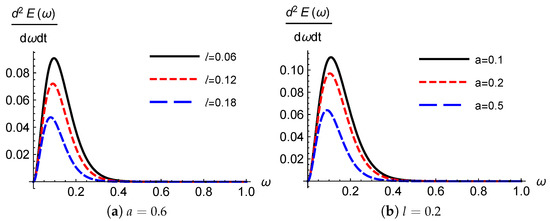
Figure 8.
The energy emission rate in model A. Panels (a,b) show the effects of the nonlocal parameter l and the rotation parameter a, respectively.
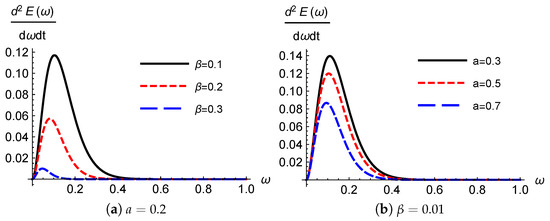
Figure 9.
The energy emission rate in model B. Panels (a,b) show the effects of the nonlocal parameter and the rotation parameter a, respectively.
6. The Case with Plasma
In this section, we investigate the shadow of the nonlocally modified black hole in the presence of the plasma. Let us consider a nonmagnetized pressureless plasma with plasma frequency
where e and denote the charge and mass of an electron, respectively, and stands for the number density of electrons in the plasma. Then, photons propagating in this plasma can be given by the modified Hamiltonian [65,66,73]
where is the 4-momentum of the photon. Provided the plasma frequency is only a function of r and , the energy and angular momentum of the photon are still constants since . From Equation (57), the Hamilton–Jacobi equation can be written as
where S is the Jacobi action with the following separable ansatz:
It is obvious that the Hamilton–Jacobi equation can be separated only provided that the plasma frequency takes the following form [73]:
where and are some functions of r and , respectively. Then, Equation (61) can be rewritten as
It is clear that the first expression is independent of , the second one is independent of r, and is independent both of r and , thus is a constant, which is related to the Carter constant. Then, with the relations , , and , the equations of motion for the photon in the presence of the plasma are [73,74]
where
Following the same procedure as in Section 3.2, the unstable circular photon orbits should satisfy
Then, we can obtain
where and we have introduced the photon energy with for convenience. With the presence of the plasma, the celestial coordinates are modified as [73]
where and is the angular coordinate of the observer. To investigate the effects of the plasma on the shadow of the black hole, we choose and as an example, i.e., the plasma frequency has the following form:
where is a constant. For later convenience, defining , we have and .
Figure 10 and Figure 11 plot the shadow of the black hole surrounded by the plasma for model A and model B, respectively. It is clear that the size of the silhouette decreases with k for both models. Additionally, Figure 10b and Figure 11b show that the distortion parameter decreases with k and vanishes when k approaches its maximum , which indicates that the deformed shadow recovers to the standard circle at . Figure 10c and Figure 11c show that the shadow shrinks to a point when . Since at this maximum the photon region for light rays crossing the equatorial plane vanishes, observers close to the equatorial plane no longer see a shadow.
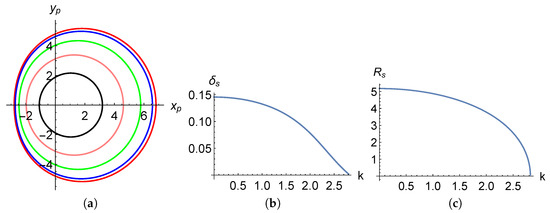
Figure 10.
The case for a rotating black hole surrounded by a plasma in model A. Panels (a–c) plot the shadow, the distortion parameter, and the radius of the black hole, respectively. Here, , , , and for red circle, for blue circle, for green circle, for pink circle, for black circle. When , the shadow shrinks to a point.
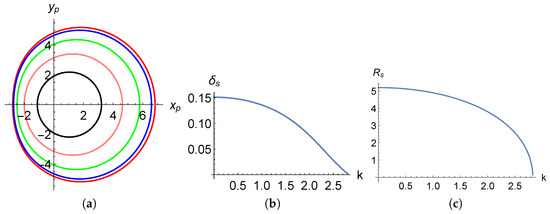
Figure 11.
The case for a rotating black hole surrounded by a plasma in model B. Panels (a–c) plot the shadow, the distortion parameter, and the radius of the black hole, respectively. Here, , , , and for red circle, for blue circle, for green circle, for pink circle, for black circle. When , the shadow shrinks to a point.
7. Gravitational Deflection of Light by Black Hole
In this section, we will give a brief analysis about the weak deflection angle of light by rotating nonlocally modified black holes given in the above sections with the Gauss–Bonnet theorem [45,46]. It is well known that the rotating black hole spacetime (22) gives rise to a Finslerian optical metric of Randers type [46], with a positive definite Hessian
and the Randers metric can be written as follows:
where denotes the Riemannian metric and is a one-form satisfying . After some simple calculations, one can obtain the following expression for the Randers metric:
where we have set without loss of generality. Then, one can construct a Riemannian manifold () osculating the Randers manifold () by applying Nazım’s method. This can be carried out by choosing a smooth and nonzero vector field over with the definition . Since we are only interested in the leading terms of the weak deflection angle, it suffices to take as the zero-order approximation of the deflected light and use the leading terms of the vector field and [46], where b is the impact parameter.
Considering a nonsingular and simply connected domain , which is bounded by the light ray and a circular curve of radius R centered on the lens, in the equatorial plane of the osculating Riemannian manifold defined above, the Gauss–Bonnet theorem states that [45,46]
where K is the Gaussian curvature of the domain , is the geodesic curvature of the boundary defined as , and stands for the th exterior angles. For the light ray intersecting the circular curve in the observer O and the source S, there are only two exterior angles, and . Letting , the exterior angles yield . In addition, in this limit, the geodesic curvature of the circular curve reduces to and . Then, Equation (78) becomes
where we have used and the Euler characteristic . Then, the weak deflection angle can be formally expressed as
Let us now compute the metric of the osculating Riemannian manifold. From Equations (75) and (77), we have
with the determinant given as
The corresponding Gaussian curvature of the domain is
where
Then, the weak deflection angle of light by the rotating nonlocally modified black holes obtained in the above sections can be calculated as
where the positive and negative signs represent the retrograde and prograde light rays, respectively. It is obvious that the nonlocal parameter l makes a positive contribution to the deflection angle and its contribution is larger than the rotation parameter a. The nonlocal parameter makes a negative contribution and is suppressed by , thus its influence can be ignored compared with the rotation parameter a.
8. Conclusions
In this paper, we constructed two kinds of rotating black hole solutions in the nonlocally modified gravitational theory by using the Newman–Janis algorithm without complexification. We first investigated the effects of the nonlocal correction on the black hole shadow by analyzing the null geodesics of the spacetime of these two types of rotating black holes, and then calculated the weak deflection angle of light by these two rotating black holes with the Gauss–Bonnet theorem.
Without loss of generality, we assume the observer is located at the equatorial plane of the black hole. It was found that the size of the shadow decreases with the nonlocal parameters. The reason is that the strength of the gravitational interaction decreases with the nonlocal parameters at a fixed proper distance to the center of the black hole, which results in a smaller escape velocity. A smaller escape velocity will lead to a more compact event horizon. Furthermore, since the prograde photon experiences a smaller unstable circular orbit compared with the retrograde photon, the black hole shadow is no longer circular. Since the radius of the smaller unstable circular orbit decreases with the rotation parameter while the radius of the larger unstable circular orbit increases with the rotation parameter, the black hole shadow shifts to the right with the increasing rotation parameter. As the radius of the prograde orbit decreases faster than the retrograde orbit increases, the shape of the shadow becomes more deformed with the rotation parameter. However, the size of the black hole shadow almost does not change with the rotation parameter since the rotation parameter has no influence on the strength of the gravitational force. In addition, the shapes of the shadow remain approximately circular when the rotation parameter is small even if the nonlocal parameter approaches its extremum.
Then, we studied the radius and distortion of the black hole shadow in both models. The results showed that the radius of both models decreases with the nonlocal parameters because of the decrease in the strength of the gravitational interaction, which is in consistence with the former analysis. Additionally, the distortions for both models increase with the nonlocal parameters and the shadow becomes more deformed with larger rotation parameter for fixed nonlocal parameters. Assuming the area of the black hole shadow is equal to the high-energy absorption cross section, the energy emission rate was also investigated. It was found that there exists a peak for each curve and the peak decreases and shifts to the low frequency with the increasing nonlocal parameters. In addition, the peak also decreases with the rotation parameter for fixed nonlocal parameters, since the area of the event horizon decreases with the nonlocal parameters.
Next, we also discussed the effects of the plasma on the black hole shadow. It was shown that the size of the shadow decreases with the presence of plasma for both models. Additionally, the deformed shadow recovers to the standard circle gradually with increasing k and shrinks to a point at the maximum , which is because the photon region for light rays crossing the equatorial plane vanishes, i.e., the shadow becomes invisible for the observer close to the equatorial plane.
Finally, we calculated the weak deflection angle of light by these two rotating black holes and analyzed the effects of the nonlocal correction on the deflection angle. It was found that the nonlocal parameter of model A makes a positive contribution to the deflection angle, which can be compared with that of the angular momentum of the black hole. The nonlocal parameter of model B makes a negative contribution. However, its influence is suppressed by and thus can be ignored compared with the rotation parameter.
In this paper, the nonlocality led by the Lagrangian is discussed. Actually, the nonlocality can also be led by a quadratic term such as in the Lagrangian. This is also an important case and deserves to be discussed in detail in the same framework. We will make a detailed analysis for the case of nonlocality from quadratic term in a future work.
Author Contributions
Conceptualization, Q.-M.F., S.-W.W., L.Z., Y.-X.L. and X.Z.; methodology, Q.-M.F., S.-W.W., L.Z., Y.-X.L. and X.Z.; validation, Q.-M.F., S.-W.W., L.Z., Y.-X.L. and X.Z.; formal analysis, Q.-M.F.; investigation, Q.-M.F., S.-W.W., L.Z., Y.-X.L. and X.Z.; writing—original draft preparation, Q.-M.F.; writing—review and editing, Q.-M.F., Y.-X.L. and X.Z.; supervision, X.Z.; project administration, X.Z.; funding acquisition, X.Z. All authors have read and agreed to the published version of the manuscript.
Funding
This research was funded by the National Natural Science Foundation of China (grant numbers 11875151, 12075103, 11975072, 11835009, 11875102, and 11690021), the Liaoning Revitalization Talents Program (grant number XLYC1905011), the Fundamental Research Funds for the Central Universities (grant number N2005030), the National Program for Support of Top-Notch Young Professionals (grant number W02070050), the Science Research Grants from the China Manned Space Project (grant number CMS-CSST-2021-B01), the National 111 Project of China (grant number B16009), and the Education Department of Shaanxi Province (grant number 20JK0553).
Institutional Review Board Statement
Not applicable.
Informed Consent Statement
Not applicable.
Data Availability Statement
Not applicable.
Acknowledgments
We thank Hao Yu for helpful discussions.
Conflicts of Interest
The authors declare no conflict of interest.
References
- Takahashi, R. It Shapes and positions of black hole shadows in accretion disks and spin parameters of black holes. Astrophys. J. 2004, 611, 996. [Google Scholar] [CrossRef]
- Tsukamoto, N.; Li, Z.L.; Bambi, C. Constraining the spin and the deformation parameters from the black hole shadow. JCAP 2014, 1406, 043. [Google Scholar] [CrossRef] [Green Version]
- Zakharov, A.F.; Paolis, F.D.; Ingrosso, G.; Nucita, A.A. Measuring the black hole parameters in the galactic center with RADIOASTRON. New Astron. 2005, 10, 479. [Google Scholar] [CrossRef]
- Hioki, K.; Maeda, K. Measurement of the Kerr spin parameter by observation of a compact object’s shadow. Phys. Rev. D 2009, 80, 024042. [Google Scholar] [CrossRef] [Green Version]
- Zakharov, A.F. Constraints on a charge in the Reissner-Nordström metric for the black hole at the Galactic Center. Phys. Rev. D 2014, 90, 062007. [Google Scholar] [CrossRef] [Green Version]
- Li, Z.L.; Bambi, C. Measuring the Kerr spin parameter of regular black holes from their shadow. JCAP 2014, 1401, 041. [Google Scholar] [CrossRef] [Green Version]
- Neves, J.C.S. Constraining the tidal charge of brane black holes using their shadows. Eur. Phys. J. C 2020, 80, 717. [Google Scholar] [CrossRef]
- Amarilla, L.; Eiroa, E.F.; Giribet, G. Null geodesics and shadow of a rotating black hole in extended Chern-Simons modified gravity. Phys. Rev. D 2010, 81, 124045. [Google Scholar] [CrossRef] [Green Version]
- Moffat, J.W. Modified Gravity Black Holes and their Observable Shadows. Eur. Phys. J. C 2015, 75, 130. [Google Scholar] [CrossRef]
- Amarilla, L.; Eiroa, E.F. Shadow of a rotating braneworld black hole. Phys. Rev. D 2012, 85, 064019. [Google Scholar] [CrossRef] [Green Version]
- Amarilla, L.; Eiroa, E.F. Shadow of a Kaluza-Klein rotating dilaton black hole. Phys. Rev. D 2013, 87, 044057. [Google Scholar] [CrossRef] [Green Version]
- Synge, J.L. The escape of photons from gravitationally intense stars. Mon. Not. Roy. Astron. Soc. 1966, 131, 463. [Google Scholar] [CrossRef]
- Luminet, J.P. Image of a spherical black hole with thin accretion disk. Astron. Astrophys. 1979, 75, 228. [Google Scholar]
- Bardeen, J.M. Timelike and Null Geodesics of the Kerr Metric; Gordon and Breach: New York, NY, USA, 1973. [Google Scholar]
- Mishra, A.K.; Chakraborty, S.; Sarkar, S. Understanding photon sphere and black hole shadow in dynamically evolving spacetimes. Phys. Rev. D 2019, 99, 104080. [Google Scholar] [CrossRef] [Green Version]
- Perlick, V.; Tsupko, O.Y.; Bisnovatyi-Kogan, G.S. Black hole shadow in an expanding universe with a cosmological constant. Phys. Rev. D 2018, 97, 104062. [Google Scholar] [CrossRef] [Green Version]
- Haroon, S.; Jamil, M.; Jusu, K.; Lin, K.; Mann, R.B. Shadow and Deflection Angle of Rotating Black Holes in Perfect Fluid Dark Matter with a Cosmological Constant. Phys. Rev. D 2019, 99, 044015. [Google Scholar] [CrossRef] [Green Version]
- Grenzebach, A.; Perlick, V.; Lämmerzahl, C. Photon Regions and Shadows of Kerr-Newman-NUT Black Holes with a Cosmological Constant. Phys. Rev. D 2014, 89, 124004. [Google Scholar] [CrossRef] [Green Version]
- Li, P.C.; Guo, M.Y.; Chen, B. Shadow of a Spinning Black Hole in an Expanding Universe. Phys. Rev. D 2020, 101, 084041. [Google Scholar] [CrossRef] [Green Version]
- Amir, M.; Ghosh, S.G. Shapes of rotating nonsingular black hole shadows. Phys. Rev. D 2016, 94, 024054. [Google Scholar] [CrossRef] [Green Version]
- Abdujabbarov, A.; Amir, M.; Ahmedov, B.; Ghosh, S.G. Shadow of rotating regular black holes. Phys. Rev. D 2016, 93, 104004. [Google Scholar] [CrossRef] [Green Version]
- Younsi, Z.; Zhidenko, A.; Rezzolla, L.; Konoplya, R.; Mizuno, Y. New method for shadow calculations: Application to parametrized axisymmetric black holes. Phys. Rev. D 2016, 94, 084025. [Google Scholar] [CrossRef] [Green Version]
- Jusufi, K. Connection Between the Shadow Radius and Quasinormal Modes in Rotating Spacetimes. Phys. Rev. D 2020, 101, 124063. [Google Scholar] [CrossRef]
- Konoplya, R.A. Quantum corrected black holes: Quasinormal modes, scattering, shadows. Phys. Lett. B 2020, 804, 135363. [Google Scholar] [CrossRef]
- Liu, C.; Zhu, T.; Wu, Q.; Jusufi, K.; Jamil, M.; Azreg-Anou, M.; Wang, A.Z. Shadow and Quasinormal Modes of a Rotating Loop Quantum Black Hole. Phys. Rev. D 2020, 101, 084001. [Google Scholar] [CrossRef] [Green Version]
- Atamurotov, F.; Abdujabbarov, A.; Ahmedov, B. Shadow of rotating non-Kerr black hole. Phys. Rev. D 2013, 88, 064004. [Google Scholar] [CrossRef]
- Wei, S.W.; Liu, Y.X. Observing the shadow of Einstein-Maxwell-Dilaton-Axion black hole. JCAP 2013, 1311, 063. [Google Scholar] [CrossRef] [Green Version]
- Lu, R.S.; Broderick, A.E.; Baron, F.; Monnier, J.D.; Fish, V.L.; Doeleman, S.S.; Pankratius, V. Imaging the Supermassive Black Hole Shadow and Jet Base of M87 with the Event Horizon Telescope. Astrophys. J. 2014, 788, 120. [Google Scholar] [CrossRef]
- Papnoi, U.; Atamurotov, F.; Ghosh, S.G.; Ahmedov, B. Shadow of five-dimensional rotating Myers-Perry black hole. Phys. Rev. D 2014, 90, 024073. [Google Scholar] [CrossRef] [Green Version]
- Moffat, J.W. Black Holes in Modified Gravity (MOG). Eur. Phys. J. C 2015, 75, 175. [Google Scholar] [CrossRef]
- Cunha, P.V.P.; Herdeiro, C.A.R.; Radu, E.; Runarsson, H.F. Shadows of Kerr black holes with scalar hair. Phys. Rev. Lett. 2015, 115, 211102. [Google Scholar] [CrossRef] [Green Version]
- Cunha, P.V.P.; Herdeiro, C.A.R.; Kleihaus, B.; Kunz, J.; Radu, E. Shadows of Einstein-dilaton-Gauss-Bonnet black holes. Phys. Lett. B 2017, 768, 373. [Google Scholar] [CrossRef]
- Bisnovatyi-Kogan, G.S.; Tsupko, O.Y. Shadow of a black hole at cosmological distances. Phys. Rev. D 2018, 98, 084020. [Google Scholar] [CrossRef] [Green Version]
- Wei, S.W.; Zou, Y.C.; Liu, Y.X.; Mann, R.B. Curvature radius and Kerr black hole shadow. JCAP 2019, 1908, 030. [Google Scholar] [CrossRef] [Green Version]
- Gralla, S.E.; Holz, D.E.; Wald, R.M. Black Hole Shadows, Photon Rings, and Lensing Rings. Phys. Rev. D 2019, 100, 024018. [Google Scholar] [CrossRef] [Green Version]
- Kumar, R.; Ghosh, S.G.; Wang, A.Z. Gravitational deflection of light and shadow cast by rotating Kalb-Ramond black holes. Phys. Rev. D 2020, 101, 104001. [Google Scholar] [CrossRef]
- Guo, M.Y.; Li, P.C. Innermost stable circular orbit and shadow of the 4D Einstein-Gauss-Bonnet black hole. Eur. Phys. J. C 2020, 80, 588. [Google Scholar] [CrossRef]
- Virbhadra, K.S.; Ellis, G.F.R. Schwarzschild black hole lensing. Phys. Rev. D 2000, 62, 084003. [Google Scholar] [CrossRef] [Green Version]
- Virbhadra, K.S.; Ellis, G.F.R. Gravitational lensing by naked singularities. Phys. Rev. D 2002, 65, 103004. [Google Scholar] [CrossRef]
- Bozza, V. Gravitational lensing in the strong field limit. Phys. Rev. D 2002, 66, 103001. [Google Scholar] [CrossRef] [Green Version]
- Perlick, V. On the Exact gravitational lens equation in spherically symmetric and static space-times. Phys. Rev. D 2004, 69, 064017. [Google Scholar] [CrossRef] [Green Version]
- Hoekstra, H.; Yee, H.K.C.; Gladders, M.D. Properties of galaxy dark matter halos from weak lensing. Astrophys. J. 2004, 606, 67. [Google Scholar] [CrossRef] [Green Version]
- Gallo, E.; Moreschi, O.M. Gravitational lens optical scalars in terms of energy-momentum distributions. Phys. Rev. D 2011, 83, 083007. [Google Scholar] [CrossRef] [Green Version]
- Nam, C.H. Implications for the hierarchy problem, inflation and geodesic motion from fiber fabric of spacetime. Eur. Phys. J. C 2021, 81, 1102. [Google Scholar] [CrossRef]
- Gibbons, G.W.; Werner, M.C. Applications of the Gauss-Bonnet theorem to gravitational lensing. Class. Quant. Grav. 2008, 25, 235009. [Google Scholar] [CrossRef]
- Werner, M.C. Gravitational lensing in the Kerr-Randers optical geometry. Gen. Relativ. Gravit. 2012, 44, 3047. [Google Scholar] [CrossRef] [Green Version]
- Jusufi, K. Gravitational lensing by Reissner-Nordstrom black holes with topological defects. Astrophys. Space Sci. 2016, 361, 24. [Google Scholar] [CrossRef] [Green Version]
- Jusufi, K.; Werner, M.C.; Banerjee, A.; Övgün, A. Light deflection by a rotating global monopole spacetime. Phys. Rev. D 2017, 95, 104012. [Google Scholar] [CrossRef] [Green Version]
- Jusufi, K.; Övgün, A. Gravitational lensing by rotating wormholes. Phys. Rev. D 2018, 97, 024042. [Google Scholar] [CrossRef] [Green Version]
- Jusufi, K.; Övgün, A.; Saavedra, J.; Vasquez, Y.; Gonzalez, P.A. Deflection of light by rotating regular black holes using the Gauss-Bonnet theorem. Phys. Rev. D 2018, 97, 124024. [Google Scholar] [CrossRef] [Green Version]
- Arakida, H. Light deflection and Gauss-Bonnet theorem: Definition of total deflection angle and its applications. Gen. Relativ. Gravit. 2018, 50, 48. [Google Scholar] [CrossRef] [Green Version]
- Övgün, A.; Gyulchev, G.; Jusufi, K. Weak Gravitational lensing by phantom black holes and phantom wormholes using the Gauss-Bonnet theorem. Ann. Phys. 2019, 406, 152. [Google Scholar] [CrossRef] [Green Version]
- Javed, W.; Babar, R.; Övgün, A. The effect of the Brane-Dicke coupling parameter on weak gravitational lensing by wormholes and naked singularities. Phys. Rev. D 2019, 99, 084012. [Google Scholar] [CrossRef] [Green Version]
- Kumar, R.; Ghosh, S.G.; Wang, A.Z. Shadow cast and deflection of light by charged rotating regular black holes. Phys. Rev. D 2019, 100, 124024. [Google Scholar] [CrossRef] [Green Version]
- Zhang, Z. Geometrization of light bending and its application to SdS spacetime. Class. Quant. Grav. 2022, 39, 015003. [Google Scholar] [CrossRef]
- Jusufi, K. Gravitational deflection of relativistic massive particles by Kerr black holes and Teo wormholes viewed as a topological effect. Phys. Rev. D 2018, 98, 064017. [Google Scholar] [CrossRef] [Green Version]
- Li, Z.H.; Jia, J.J. The finite-distance gravitational deflection of massive particles in stationary spacetime: A Jacobi metric approach. Eur. Phys. J. C 2020, 80, 157. [Google Scholar] [CrossRef] [Green Version]
- Li, Z.H.; Duan, Y.J.; Jia, J.J. The deflection of charged massive particles by a 4-Dimensional charged Einstein-Gauss-Bonnet black hole. arXiv 2020, arXiv:2012.14226. [Google Scholar]
- Ono, T.; Ishihara, A.; Asada, H. Gravitomagnetic bending angle of light with finite-distance corrections in stationary axisymmetric spacetimes. Phys. Rev. D 2017, 96, 104037. [Google Scholar] [CrossRef] [Green Version]
- Ono, T.; Ishihara, A.; Asada, H. Deflection angle of light for an observer and source at finite distance from a rotating wormhole. Phys. Rev. D 2018, 98, 044047. [Google Scholar] [CrossRef] [Green Version]
- Crisnejo, G.; Gallo, E.; Rogers, A. Finite distance corrections to the light deflection in a gravitational field with a plasma medium. Phys. Rev. D 2019, 99, 124001. [Google Scholar] [CrossRef] [Green Version]
- Muhleman, D.O.; Johnston, I.D. Radio propagation in the solar gravitational field. Phys. Rev. Lett. 1966, 17, 455. [Google Scholar] [CrossRef]
- Muhleman, D.O.; Ekers, R.D.; Fomalont, E.B. Radio interferometric test of the general relativistic light bending near the sun. Phys. Rev. Lett. 1970, 24, 1377. [Google Scholar] [CrossRef]
- Perlick, V. Ray Optics, Fermat’s Principle, and Applications to General Relatively; Springer: Berlin, Germany, 2000. [Google Scholar]
- Bisnovatyi-Kogan, G.S.; Tsupko, O.Y. Gravitational lensing in a non-uniform plasma. Not. Roy. Astron. Soc. 2010, 404, 1790. [Google Scholar] [CrossRef] [Green Version]
- Rogers, A. Frequency-dependent effects of gravitational lensing within plasma. Mon. Not. Roy. Astron. Soc. 2015, 451, 17. [Google Scholar] [CrossRef]
- Morozova, V.; Ahmedov, B.; Tursunov, A. Gravitational lensing by a rotating massive object in a plasma. Astrophys. Space Sci. 2013, 346, 513. [Google Scholar] [CrossRef] [Green Version]
- Benavides-Gallego, C.A.; Abdujabbarov, A.A.; Bambi, C. Gravitational lensing for a boosted Kerr black hole in the presence of plasma. Eur. Phys. J. C 2018, 78, 694. [Google Scholar] [CrossRef]
- Crisnejo, G.; Gallo, E. Weak lensing in a plasma medium and gravitational deflection of massive particles using the Gauss-Bonnet theorem. A unified treatment. Phys. Rev. D 2018, 97, 124016. [Google Scholar] [CrossRef] [Green Version]
- Bisnovatyi-Kogan, G.; Tsupko, O. Gravitational Lensing in Presence of Plasma: Strong Lens Systems, Black Hole Lensing and Shadow. Universe 2017, 3, 57. [Google Scholar] [CrossRef] [Green Version]
- Atamurotov, F.; Ahmedov, B. Optical properties of black hole in the presence of plasma: Shadow. Phys. Rev. D 2015, 92, 084005. [Google Scholar] [CrossRef] [Green Version]
- Perlick, V.; Tsupko, O.Y.; Bisnovatyi-Kogan, G.S. Influence of a plasma on the shadow of a spherically symmetric black hole. Phys. Rev. D 2015, 92, 104031. [Google Scholar] [CrossRef] [Green Version]
- Perlick, V.; Tsupko, O.Y. Light propagation in a plasma on Kerr spacetime: Separation of the Hamilton-Jacobi equation and calculation of the shadow. Phys. Rev. D 2017, 95, 104003. [Google Scholar] [CrossRef] [Green Version]
- Yan, H.P. Influence of a plasma on the observational signature of a high-spin Kerr black hole. Phys. Rev. D 2019, 99, 084050. [Google Scholar] [CrossRef] [Green Version]
- Bisnovatyi-Kogan, G.S.; Tsupko, O.Y. Gravitational Lensing in Plasmic Medium. Plasma Phys. Rep. 2015, 41, 562. [Google Scholar] [CrossRef] [Green Version]
- Das, S.; Vagenas, E.C. Universality of Quantum Gravity Corrections. Phys. Rev. Lett. 2008, 101, 221301. [Google Scholar] [CrossRef] [Green Version]
- Masood, S.; Faizal, M.; Zaz, Z.; Ali, A.F.; Raza, J.; Shah, M.B. The most general form of deformation of the Heisenberg algebra from the generalized uncertainty principle. Phys. Lett. B 2016, 763, 218. [Google Scholar] [CrossRef] [Green Version]
- Modesto, L.; Shapiro, I.L. Superrenormalizable quantum gravity with complex ghosts. Phys. Lett. B 2016, 755, 279. [Google Scholar] [CrossRef]
- Modesto, L. Super-renormalizable or finite Lee-Wick quantum gravity. Nucl. Phys. B 2016, 909, 584. [Google Scholar] [CrossRef] [Green Version]
- Faizal, M.; Ali, A.F.; Nassar, A. Generalized uncertainty principle as a consequence of the effective field theory. Phys. Lett. B 2017, 765, 238. [Google Scholar] [CrossRef]
- Elizalde, E.; Odintsov, S.D. A Renormalization group improved nonlocal gravitational effective Lagrangian. Mod. Phys. Lett. A 1995, 10, 1821. [Google Scholar] [CrossRef]
- Modesto, L.; Moffat, J.W.; Nicolini, P. Black holes in an ultraviolet complete quantum gravity. Phys. Lett. B 2011, 695, 397. [Google Scholar] [CrossRef] [Green Version]
- Chicone, C.; Mashhoon, B. Linearized Gravitational Waves in Nonlocal General Relativity. Phys. Rev. D 2013, 87, 064015. [Google Scholar] [CrossRef] [Green Version]
- Joshi, P.; Kumar, U.; Panda, S. Hamiltonian formalism for nonlocal gravity models. Int. J. Geom. Meth. Mod. Phys. 2022, 19, 2250036. [Google Scholar] [CrossRef]
- Moffat, J.W. Ultraviolet Complete Quantum Gravity. Eur. Phys. J. Plus 2011, 126, 43. [Google Scholar] [CrossRef] [Green Version]
- Biswas, T.; Koivisto, T.; Mazumdar, A. Towards a resolution of the cosmological singularity in non-local higher derivative theories of gravity. JCAP 2010, 1011, 008. [Google Scholar] [CrossRef] [Green Version]
- Modesto, L. Super-renormalizable Quantum Gravity. Phys. Rev. D 2012, 86, 044005. [Google Scholar] [CrossRef] [Green Version]
- Modesto, L.; Rachwal, L. Super-renormalizable and finite gravitational theories. Nucl. Phys. B 2014, 889, 228. [Google Scholar] [CrossRef] [Green Version]
- Maggiore, M. Phantom dark energy from nonlocal infrared modifications of general relativity. Phys. Rev. D 2014, 89, 043008. [Google Scholar] [CrossRef] [Green Version]
- Narain, G.; Li, T.J. Ultraviolet complete dark energy model. Phys. Rev. D 2018, 97, 083523. [Google Scholar] [CrossRef] [Green Version]
- Kumar, U.; Panda, S.; Patel, A. Metric for Rotating object in Infrared Corrected Nonlocal Gravity Model. Phys. Rev. D 2018, 98, 124040. [Google Scholar] [CrossRef] [Green Version]
- Tian, S.X.; Zhu, Z.H. Revisiting scalar and tensor perturbations in a nonlocal gravity. Phys. Rev. D 2019, 100, 124059. [Google Scholar] [CrossRef] [Green Version]
- Dirian, Y.; Foffa, S.; Khosravi, N.; Kunz, M.; Maggiore, M. Cosmological perturbations and structure formation in nonlocal infrared modifications of general relativity. JCAP 2014, 1406, 033. [Google Scholar] [CrossRef] [Green Version]
- Dirian, Y.; Foffa, S.; Kunz, M.; Maggiore, M.; Pettorino, V. Non-local gravity and comparison with observational datasets. JCAP 2015, 1504, 044. [Google Scholar] [CrossRef] [Green Version]
- Dirian, Y.; Foffa, S.; Kunz, M.; Maggiore, M.; Pettorino, V. Non-local gravity and comparison with observational datasets. II. Updated results and Bayesian model comparison with ΛCDM. JCAP 2016, 1605, 068. [Google Scholar] [CrossRef] [Green Version]
- Nicolini, P. Nonlocal and generalized uncertainty principle black holes. arXiv 2012, arXiv:1202.2102. [Google Scholar]
- Isi, M.; Mureika, J.; Nicolini, P. Self-Completeness and the Generalized Uncertainty Principle. JHEP 2013, 1311, 139. [Google Scholar] [CrossRef] [Green Version]
- Frolov, V.P. Mass-gap for black hole formation in higher derivative and ghost free gravity. Phys. Rev. Lett. 2015, 115, 051102. [Google Scholar] [CrossRef] [PubMed]
- Knipfer, M.; Köppel, S.; Mureika, J.; Nicolini, P. Generalized Uncertainty Principle and Black Holes in Higher Dimensional Self-Complete Gravity. JCAP 2019, 1908, 008. [Google Scholar] [CrossRef] [Green Version]
- Platania, A. Dynamical renormalization of black-hole spacetimes. Eur. Phys. J. C 2019, 79, 470. [Google Scholar] [CrossRef]
- Nicolini, P.; Smailagic, A.; Spallucci, E. Noncommutative geometry inspired Schwarzschild black hole. Phys. Lett. B 2006, 632, 547. [Google Scholar] [CrossRef] [Green Version]
- Platania, A. From renormalization group flows to cosmology. Front. Phys. 2020, 8, 188. [Google Scholar] [CrossRef]
- Knorr, B.; Platania, A. Sifting quantum black holes through the principle of least action. arXiv 2022, arXiv:2202.01216. [Google Scholar]
- Newman, E.; Janis, A. Note on the Kerr spinning particle metric. J. Math. Phys. 1965, 6, 915. [Google Scholar] [CrossRef]
- Newman, E.T.; Couch, R.; Chinnapared, K.; Exton, A.; Prakash, A.; Torrence, R. Metric of a Rotating, Charged Mass. J. Math. Phys. 1965, 6, 918. [Google Scholar] [CrossRef]
- Johannsen, T.; Psaltis, D. A Metric for Rapidly Spinning Black Holes Suitable for Strong-Field Tests of the No-Hair Theorem. Phys. Rev. D 2011, 83, 124015. [Google Scholar] [CrossRef] [Green Version]
- Bambi, C.; Modesto, L. Rotating regular black holes. Phys. Lett. B 2013, 721, 329. [Google Scholar] [CrossRef] [Green Version]
- Ghosh, S.G.; Maharaj, S.D. Radiating Kerr-like regular black hole. Eur. Phys. J. C 2015, 75, 7. [Google Scholar] [CrossRef] [Green Version]
- Jusufi, K.; Jamil, M.; Chakrabarty, H.; Wu, Q.; Bambi, C.; Wang, A. Rotating regular black holes in conformal massive gravity. Phys. Rev. D 2020, 101, 044035. [Google Scholar] [CrossRef] [Green Version]
- Azreg-Aïnou, M. Generating rotating regular black hole solutions without complexification. Phys. Rev. D 2014, 90, 064041. [Google Scholar] [CrossRef] [Green Version]
- Chandrasekhar, S. The Mathematical Theory of Black Holes; Oxford University Press: New York, NY, USA, 1983. [Google Scholar]
- Bardeen, J.M.; Press, W.H.; Teukolsky, S.A. Rotating black holes: Locally nonrotating frames, energy extraction, and scalar synchrotron radiation. Astrophys. J. 1972, 178, 347. [Google Scholar] [CrossRef]
- Cunningham, C.T.; Bardeen, J.M. The optical appearance of a star orbiting an extreme Kerr black hole. Astrophys. J. 1973, 183, 237. [Google Scholar] [CrossRef]
- Cunningham, C.T. The effects of redshifts and focusing on the spectrum of an accretion disk around a Kerr black hole. Astrophys. J. 1975, 202, 788. [Google Scholar] [CrossRef]
- Carter, B. Hamilton-Jacobi and Schrodinger separable solutions of Einstein’s equations. Commun. Math. Phys. 1968, 10, 280. [Google Scholar] [CrossRef]
- Event Horizon Telescope Collaboration; Akiyama, K.; Alberdi, A.; Alef, W.; Asada, K.; Azulay, R.; Baczko, A.; Ball, D.; Baloković, M.; Barrett, J.; et al. First M87 Event Horizon Telescope Results. I. The shadow of the supermassive black hole. Astrophys. J. 2019, 875, L1. [Google Scholar]
- Bambi, C.; Freese, K.; Vagnozzi, S.; Visinelli, L. Testing the rotational nature of the supermassive object M87* from the circularity and size of its first image. Phys. Rev. D 2019, 100, 044057. [Google Scholar] [CrossRef] [Green Version]
- Mashhoon, B. Scattering of Electromagnetic Radiation from a Black Hole. Phys. Rev. D 1973, 7, 2807. [Google Scholar] [CrossRef]
- Parikh, M.K.; Wilczek, F. Hawking radiation as tunneling. Phys. Rev. Lett. 2000, 85, 5042. [Google Scholar] [CrossRef] [Green Version]
- Padmanabhan, T. Gravity and the thermodynamics of horizons. Phys. Rept. 2005, 406, 49. [Google Scholar] [CrossRef] [Green Version]
Publisher’s Note: MDPI stays neutral with regard to jurisdictional claims in published maps and institutional affiliations. |
© 2022 by the authors. Licensee MDPI, Basel, Switzerland. This article is an open access article distributed under the terms and conditions of the Creative Commons Attribution (CC BY) license (https://creativecommons.org/licenses/by/4.0/).